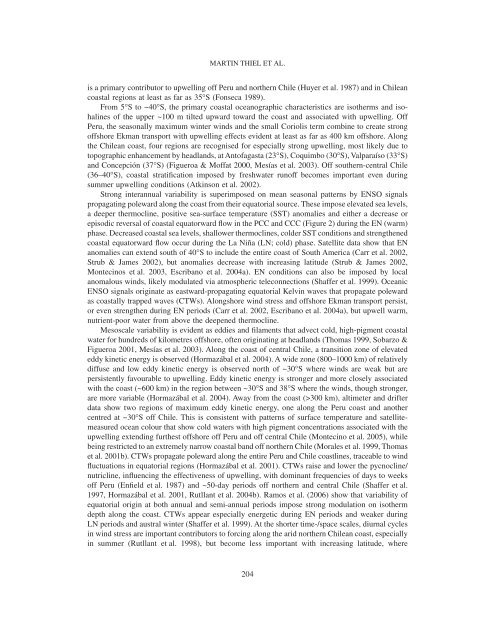the humboldt current system of northern and central chile - figema
the humboldt current system of northern and central chile - figema
the humboldt current system of northern and central chile - figema
You also want an ePaper? Increase the reach of your titles
YUMPU automatically turns print PDFs into web optimized ePapers that Google loves.
MARTIN THIEL ET AL.is a primary contributor to upwelling <strong>of</strong>f Peru <strong>and</strong> nor<strong>the</strong>rn Chile (Huyer et al. 1987) <strong>and</strong> in Chileancoastal regions at least as far as 35°S (Fonseca 1989).From 5°S to ~40°S, <strong>the</strong> primary coastal oceanographic characteristics are iso<strong>the</strong>rms <strong>and</strong> isohalines<strong>of</strong> <strong>the</strong> upper ~100 m tilted upward toward <strong>the</strong> coast <strong>and</strong> associated with upwelling. OffPeru, <strong>the</strong> seasonally maximum winter winds <strong>and</strong> <strong>the</strong> small Coriolis term combine to create strong<strong>of</strong>fshore Ekman transport with upwelling effects evident at least as far as 400 km <strong>of</strong>fshore. Along<strong>the</strong> Chilean coast, four regions are recognised for especially strong upwelling, most likely due totopographic enhancement by headl<strong>and</strong>s, at Ant<strong>of</strong>agasta (23°S), Coquimbo (30°S), Valparaíso (33°S)<strong>and</strong> Concepción (37°S) (Figueroa & M<strong>of</strong>fat 2000, Mesías et al. 2003). Off sou<strong>the</strong>rn-<strong>central</strong> Chile(36–40°S), coastal stratification imposed by freshwater run<strong>of</strong>f becomes important even duringsummer upwelling conditions (Atkinson et al. 2002).Strong interannual variability is superimposed on mean seasonal patterns by ENSO signalspropagating poleward along <strong>the</strong> coast from <strong>the</strong>ir equatorial source. These impose elevated sea levels,a deeper <strong>the</strong>rmocline, positive sea-surface temperature (SST) anomalies <strong>and</strong> ei<strong>the</strong>r a decrease orepisodic reversal <strong>of</strong> coastal equatorward flow in <strong>the</strong> PCC <strong>and</strong> CCC (Figure 2) during <strong>the</strong> EN (warm)phase. Decreased coastal sea levels, shallower <strong>the</strong>rmoclines, colder SST conditions <strong>and</strong> streng<strong>the</strong>nedcoastal equatorward flow occur during <strong>the</strong> La Niña (LN; cold) phase. Satellite data show that ENanomalies can extend south <strong>of</strong> 40°S to include <strong>the</strong> entire coast <strong>of</strong> South America (Carr et al. 2002,Strub & James 2002), but anomalies decrease with increasing latitude (Strub & James 2002,Montecinos et al. 2003, Escribano et al. 2004a). EN conditions can also be imposed by localanomalous winds, likely modulated via atmospheric teleconnections (Shaffer et al. 1999). OceanicENSO signals originate as eastward-propagating equatorial Kelvin waves that propagate polewardas coastally trapped waves (CTWs). Alongshore wind stress <strong>and</strong> <strong>of</strong>fshore Ekman transport persist,or even streng<strong>the</strong>n during EN periods (Carr et al. 2002, Escribano et al. 2004a), but upwell warm,nutrient-poor water from above <strong>the</strong> deepened <strong>the</strong>rmocline.Mesoscale variability is evident as eddies <strong>and</strong> filaments that advect cold, high-pigment coastalwater for hundreds <strong>of</strong> kilometres <strong>of</strong>fshore, <strong>of</strong>ten originating at headl<strong>and</strong>s (Thomas 1999, Sobarzo &Figueroa 2001, Mesías et al. 2003). Along <strong>the</strong> coast <strong>of</strong> <strong>central</strong> Chile, a transition zone <strong>of</strong> elevatededdy kinetic energy is observed (Hormazábal et al. 2004). A wide zone (800–1000 km) <strong>of</strong> relativelydiffuse <strong>and</strong> low eddy kinetic energy is observed north <strong>of</strong> ~30°S where winds are weak but arepersistently favourable to upwelling. Eddy kinetic energy is stronger <strong>and</strong> more closely associatedwith <strong>the</strong> coast (~600 km) in <strong>the</strong> region between ~30°S <strong>and</strong> 38°S where <strong>the</strong> winds, though stronger,are more variable (Hormazábal et al. 2004). Away from <strong>the</strong> coast (>300 km), altimeter <strong>and</strong> drifterdata show two regions <strong>of</strong> maximum eddy kinetic energy, one along <strong>the</strong> Peru coast <strong>and</strong> ano<strong>the</strong>rcentred at ~30°S <strong>of</strong>f Chile. This is consistent with patterns <strong>of</strong> surface temperature <strong>and</strong> satellitemeasuredocean colour that show cold waters with high pigment concentrations associated with <strong>the</strong>upwelling extending fur<strong>the</strong>st <strong>of</strong>fshore <strong>of</strong>f Peru <strong>and</strong> <strong>of</strong>f <strong>central</strong> Chile (Montecino et al. 2005), whilebeing restricted to an extremely narrow coastal b<strong>and</strong> <strong>of</strong>f nor<strong>the</strong>rn Chile (Morales et al. 1999, Thomaset al. 2001b). CTWs propagate poleward along <strong>the</strong> entire Peru <strong>and</strong> Chile coastlines, traceable to windfluctuations in equatorial regions (Hormazábal et al. 2001). CTWs raise <strong>and</strong> lower <strong>the</strong> pycnocline/nutricline, influencing <strong>the</strong> effectiveness <strong>of</strong> upwelling, with dominant frequencies <strong>of</strong> days to weeks<strong>of</strong>f Peru (Enfield et al. 1987) <strong>and</strong> ~50-day periods <strong>of</strong>f nor<strong>the</strong>rn <strong>and</strong> <strong>central</strong> Chile (Shaffer et al.1997, Hormazábal et al. 2001, Rutllant et al. 2004b). Ramos et al. (2006) show that variability <strong>of</strong>equatorial origin at both annual <strong>and</strong> semi-annual periods impose strong modulation on iso<strong>the</strong>rmdepth along <strong>the</strong> coast. CTWs appear especially energetic during EN periods <strong>and</strong> weaker duringLN periods <strong>and</strong> austral winter (Shaffer et al. 1999). At <strong>the</strong> shorter time-/space scales, diurnal cyclesin wind stress are important contributors to forcing along <strong>the</strong> arid nor<strong>the</strong>rn Chilean coast, especiallyin summer (Rutllant et al. 1998), but become less important with increasing latitude, where204










